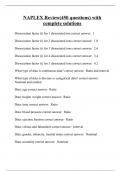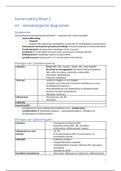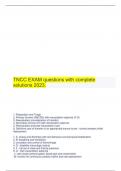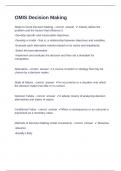Module 4 – Immune Evasion and Modulation by Viruses and Helminths
IMMUNE EVASION AND MODULATION BY VIRUSES
Viruses: can only reproduce inside living cells and move as extracellular virus
particles from cell to cell where it can be recognised by antibodies
The particle is sub-microscopical and contains RNA or DNA as genetic
material. This genome may be linear or circular, segmented or in one piece
and single or double stranded
Naked virus: the genome is surrounded by capsid proteins (nucleocapsid)
that protect the genome against the environment
o The capsid proteins bind to receptors to promote cell entry
Enveloped virus: the nucleocapsid has another layer, a lipid bilayer, on the
surface which is called the viral envelope containing of transmembrane
glycoproteins that point out from the surface
o Surface glycoproteins: may bind to receptors on the cell surface or
function as viral fusion proteins to fuse viral and host membranes
o The fusion happens directly at the surface or in endosomes where
the nucleocapsid is released into the cells
Inside the cell the viral genome is transcribed (DNA/-RNA) or directly translated
(+RNA) and the synthesis of the encoded proteins allows replication of the
genome and packaging of the newly made genomes in progeny virus particles to
infect new cells the infection can be traced by testing for pathogen-specific
antibodies in serum or mucosa (sero-positive)
When the mammalian cell senses the presence of a replicating virus inside the
cell by PAMPs, it responses by producing IFN-α/β which results in increased levels
of more IFN in the cell environment leading to activation of NK cells (innate
immune response)
Antiviral state: induced by the secretion of IFNs the expression of
protein kinase R (PKR), 2’,5’ oligoadenylate synthetase (2’-5’ OAS), RNAse
L and Mx GTPases makes the neighbouring cells more resistant to virus
infections by restricting virus propagation
o PKR: kinase that phosphorylates other proteins when activated by
dsRNA, upregulated as a response to IFN signalling by infected cells,
inactive as long as the cell is uninfected
Activated by the phosphorylation due to dsRNA which
subsequently forms dimers which then phosphorylates the α
unit of eukaryotic translation initiation factor eIF2 (eIF2α)
eIF2α leads to a halt in translation initiation (host shut off)
PKR blocks IκB and stimulates the expression of pro-
inflammatory genes
o OAS & RNAse L: also activated by dsRNA whereafter OAS does
activate RNAse L which degrades viral RNA
The activation of OAS can be prevented by viruses
o Mx GTPases: mostly activated against -RNA viruses, restrict virus
replication by interfering with the viral ribonucleoproteins formed by
RNA viruses that inhibits the viral gene expression and virion
assembly
Increased synthesis of MHC-I on the surface of infected cells better
recognition of CTLs (adaptive immune response)
Virus-specific antibodies will start to be produced that can bind to progeny
virus to limit the spread of infection (adaptive immune response)
, o Neutralising antibodies: prevent progeny virus from infecting other
body cells
Interferon regulatory factors (IRFs) translocate to the nucleus of the cell where
they function as transcription factor for IFN-α/β which drive the synthesis of more
IFN Ebola and Marburg virus interfere with IRF3/IRF7 activation, influenza
encodes a non-structural protein that interferes with the synthesis of IFN
JAK-STAT pathway: IFN from virus-infected cells binds to IFN receptors on
neighbouring cells which is transduced via this pathway and leads to gene
expression of a set of IFN responsive genes
Dimerization of IFN receptor when IFN binds which activates JAK is crucial
JAK recruits STAT to the receptor and phosphorylates STAT which forms
dimers and translocates to the nucleus there it activates the IFN
responsive promoters
VIRUSES: inhibit IFN synthesis and IFN signalling by interfering with the
JAK-STAT pathway (e.g. prevention of phosphorylation of STAT so it stays in
the cytoplasm and cannot activate IFN responsive promoters)
Influenza: A and B viruses infect the human population and constantly changes
(yearly flu vaccination is therefore needed) -ssRNA segmented with eight
pieces, each encoding a viral protein, virus particles are roughly spherical and
have an envelope composed of lipids with hemagglutinin (HA) and neuraminidase
(NA) as glycoproteins
HA (16 serotypes): bind to cell receptors and mediates fusion with the
endosomal membrane
NA (9 serotypes): enzyme that removes sialic acid residues from
glycoproteins present at the cell surface forming the receptor for influenza
virus which prevents binding of freshly released particles to already
infected cells
Antigenic drift: accumulation of mutations in the virus genome leading to a
gradual reduction of recognition by the immune system limited in DNA viruses,
more often in RNA viruses where the RNA polymerase has a high error rate
Antigenic shift: different viruses infect the same cell and replication leads to new
virus particles with RNA segments derived from both viruses and mixed genomes
Herpes: 90% of the adult population has been infected with at least one type and
most people carry the latent form of that virus which may be reactivated later in
life, e.g. fever blisters, genital herpes, chicken pox, human CMV and Pfeiffer
icosahedral capsid, dsDNA, enveloped with several glycoproteins, after cell entry
the DNA migrates to the nucleus where the genes are transcribed
No options for genetic re-assortment as the genome is non-segmented
Hides in cells of neuronal ganglia where it does not replicate during the
latent phase, only a few genes are transcribed so AP is kept to a minimum
making it hard to counteract infection after stress, other infections, or
other reduced immunological conditions (e.g. UV light) re-activation can
occur
Herpes buds into cell junctions instead of the intracellular space or lymph.
These cell junctions are not monitored by the immune system and highly
virulent forms of herpes use these junctions to infect neighbouring cells
without being spotted by the immune system
o The virus strains may be transported from neuron to neuron via the
synapses all the way to the brain
Human cytomegalovirus: usually harmless, also remains latent in the body as
DNA and can be reactivated at any time, can cause infections in the developing
embryo’s leading to an abnormal development
, Active phase: also remain largely unseen by the human immune system by
interfering with AP mediated by MHC-I molecules on the surface
Encodes five glycoproteins that interfere with the peptide loading (by
proteasomes and TAP) and the translocation through the ER and Golgi to
the cell membrane leading to reduced AP and reduced recognition by CTLs
Encodes MHC-I look-alikes to avoid killing by NK cells that are normally
activated by a reduced MHC-I expression
HIV: retrovirus that has an RNA genome which is transcribed into DNA using the
viral enzyme reverse transcriptase before it is integrated in the host genome
where it is invisible for the immune system unless gene expression occurs and
guarantees a longstanding infection due to resting memory cells infects CD4+
T cells (slow decline) and APCs making it difficult to remove the virus and other
pathogens first period of disease symptoms and a second period with hardly
any symptoms but decline in CD4+ T cells and increase in secondary infections
that are harmless
Replication cycle starts with the binding of the virion to the CD4 receptor
and a chemokine co-receptor via the HIV gp120 membrane protein to the T
cell receptor CD4 whereafter a conformational change takes place in
gp120 that promotes the binding of the chemokine co-receptor to the HIV
membrane protein gp41
o gp41 binds to the chemokine co-receptor CCR5/CXCR4 and also
undergoes a conformational change which exposes the fusion
peptide which inserts itself into the T cell membrane fusion
o Viral RNA genome enters the cytoplasm where reverse transcriptase
(high error rate) is activated and transcribes the viral RNA into
proviral DNA which is integrated into the host genome through the
viral protein integrase
o New virions bud from the cell surface and during the particles
become enveloped by host membrane
o Newly synthesized viral proteins gp120/gp41 are routed via ER and
Golgi ending up in the virion membrane after budding ready to
search for a new cell to infect
High level of genetic diversity for surface proteins gp120/gp41,
glycoproteins are heavily glycosylated making them less immunogenic
Viral strategies: gp41 remains hidden from antibodies which would
otherwise neutralise gp41 via direct cell to cell transmission without
forming extracellular particles
o The membrane of an HIV-infected cell carries the gp120/gp41
complex which is able to interact with the newly formed viral capsid
which may result in a new particle that leaves through budding and
may be inactivated by neutralizing antibodies
o gp120 binds to a CD4 molecule present on a non-infected cell which
results in the fusion of the infected cell with an uninfected cell
(mediated by gp41) the surface protein gp120 directly makes
contact with the cellular receptor of a second cell while still in the
cell membrane of the cell in which it was synthesized resulting in
multi-nucleated cells (syncytia)
Vaccine trials: antibodies that do not neutralize HIV infection but stimulate
it bind HIV particles and assist the virus to find immunological effector
cells like macrophages by binding to the Fc receptors
Host transmembrane proteins (complementary regulatory proteins, e.g.
MCP, DAF and CD59) are taken along when HIV particles bud from the cell
IMMUNE EVASION AND MODULATION BY VIRUSES
Viruses: can only reproduce inside living cells and move as extracellular virus
particles from cell to cell where it can be recognised by antibodies
The particle is sub-microscopical and contains RNA or DNA as genetic
material. This genome may be linear or circular, segmented or in one piece
and single or double stranded
Naked virus: the genome is surrounded by capsid proteins (nucleocapsid)
that protect the genome against the environment
o The capsid proteins bind to receptors to promote cell entry
Enveloped virus: the nucleocapsid has another layer, a lipid bilayer, on the
surface which is called the viral envelope containing of transmembrane
glycoproteins that point out from the surface
o Surface glycoproteins: may bind to receptors on the cell surface or
function as viral fusion proteins to fuse viral and host membranes
o The fusion happens directly at the surface or in endosomes where
the nucleocapsid is released into the cells
Inside the cell the viral genome is transcribed (DNA/-RNA) or directly translated
(+RNA) and the synthesis of the encoded proteins allows replication of the
genome and packaging of the newly made genomes in progeny virus particles to
infect new cells the infection can be traced by testing for pathogen-specific
antibodies in serum or mucosa (sero-positive)
When the mammalian cell senses the presence of a replicating virus inside the
cell by PAMPs, it responses by producing IFN-α/β which results in increased levels
of more IFN in the cell environment leading to activation of NK cells (innate
immune response)
Antiviral state: induced by the secretion of IFNs the expression of
protein kinase R (PKR), 2’,5’ oligoadenylate synthetase (2’-5’ OAS), RNAse
L and Mx GTPases makes the neighbouring cells more resistant to virus
infections by restricting virus propagation
o PKR: kinase that phosphorylates other proteins when activated by
dsRNA, upregulated as a response to IFN signalling by infected cells,
inactive as long as the cell is uninfected
Activated by the phosphorylation due to dsRNA which
subsequently forms dimers which then phosphorylates the α
unit of eukaryotic translation initiation factor eIF2 (eIF2α)
eIF2α leads to a halt in translation initiation (host shut off)
PKR blocks IκB and stimulates the expression of pro-
inflammatory genes
o OAS & RNAse L: also activated by dsRNA whereafter OAS does
activate RNAse L which degrades viral RNA
The activation of OAS can be prevented by viruses
o Mx GTPases: mostly activated against -RNA viruses, restrict virus
replication by interfering with the viral ribonucleoproteins formed by
RNA viruses that inhibits the viral gene expression and virion
assembly
Increased synthesis of MHC-I on the surface of infected cells better
recognition of CTLs (adaptive immune response)
Virus-specific antibodies will start to be produced that can bind to progeny
virus to limit the spread of infection (adaptive immune response)
, o Neutralising antibodies: prevent progeny virus from infecting other
body cells
Interferon regulatory factors (IRFs) translocate to the nucleus of the cell where
they function as transcription factor for IFN-α/β which drive the synthesis of more
IFN Ebola and Marburg virus interfere with IRF3/IRF7 activation, influenza
encodes a non-structural protein that interferes with the synthesis of IFN
JAK-STAT pathway: IFN from virus-infected cells binds to IFN receptors on
neighbouring cells which is transduced via this pathway and leads to gene
expression of a set of IFN responsive genes
Dimerization of IFN receptor when IFN binds which activates JAK is crucial
JAK recruits STAT to the receptor and phosphorylates STAT which forms
dimers and translocates to the nucleus there it activates the IFN
responsive promoters
VIRUSES: inhibit IFN synthesis and IFN signalling by interfering with the
JAK-STAT pathway (e.g. prevention of phosphorylation of STAT so it stays in
the cytoplasm and cannot activate IFN responsive promoters)
Influenza: A and B viruses infect the human population and constantly changes
(yearly flu vaccination is therefore needed) -ssRNA segmented with eight
pieces, each encoding a viral protein, virus particles are roughly spherical and
have an envelope composed of lipids with hemagglutinin (HA) and neuraminidase
(NA) as glycoproteins
HA (16 serotypes): bind to cell receptors and mediates fusion with the
endosomal membrane
NA (9 serotypes): enzyme that removes sialic acid residues from
glycoproteins present at the cell surface forming the receptor for influenza
virus which prevents binding of freshly released particles to already
infected cells
Antigenic drift: accumulation of mutations in the virus genome leading to a
gradual reduction of recognition by the immune system limited in DNA viruses,
more often in RNA viruses where the RNA polymerase has a high error rate
Antigenic shift: different viruses infect the same cell and replication leads to new
virus particles with RNA segments derived from both viruses and mixed genomes
Herpes: 90% of the adult population has been infected with at least one type and
most people carry the latent form of that virus which may be reactivated later in
life, e.g. fever blisters, genital herpes, chicken pox, human CMV and Pfeiffer
icosahedral capsid, dsDNA, enveloped with several glycoproteins, after cell entry
the DNA migrates to the nucleus where the genes are transcribed
No options for genetic re-assortment as the genome is non-segmented
Hides in cells of neuronal ganglia where it does not replicate during the
latent phase, only a few genes are transcribed so AP is kept to a minimum
making it hard to counteract infection after stress, other infections, or
other reduced immunological conditions (e.g. UV light) re-activation can
occur
Herpes buds into cell junctions instead of the intracellular space or lymph.
These cell junctions are not monitored by the immune system and highly
virulent forms of herpes use these junctions to infect neighbouring cells
without being spotted by the immune system
o The virus strains may be transported from neuron to neuron via the
synapses all the way to the brain
Human cytomegalovirus: usually harmless, also remains latent in the body as
DNA and can be reactivated at any time, can cause infections in the developing
embryo’s leading to an abnormal development
, Active phase: also remain largely unseen by the human immune system by
interfering with AP mediated by MHC-I molecules on the surface
Encodes five glycoproteins that interfere with the peptide loading (by
proteasomes and TAP) and the translocation through the ER and Golgi to
the cell membrane leading to reduced AP and reduced recognition by CTLs
Encodes MHC-I look-alikes to avoid killing by NK cells that are normally
activated by a reduced MHC-I expression
HIV: retrovirus that has an RNA genome which is transcribed into DNA using the
viral enzyme reverse transcriptase before it is integrated in the host genome
where it is invisible for the immune system unless gene expression occurs and
guarantees a longstanding infection due to resting memory cells infects CD4+
T cells (slow decline) and APCs making it difficult to remove the virus and other
pathogens first period of disease symptoms and a second period with hardly
any symptoms but decline in CD4+ T cells and increase in secondary infections
that are harmless
Replication cycle starts with the binding of the virion to the CD4 receptor
and a chemokine co-receptor via the HIV gp120 membrane protein to the T
cell receptor CD4 whereafter a conformational change takes place in
gp120 that promotes the binding of the chemokine co-receptor to the HIV
membrane protein gp41
o gp41 binds to the chemokine co-receptor CCR5/CXCR4 and also
undergoes a conformational change which exposes the fusion
peptide which inserts itself into the T cell membrane fusion
o Viral RNA genome enters the cytoplasm where reverse transcriptase
(high error rate) is activated and transcribes the viral RNA into
proviral DNA which is integrated into the host genome through the
viral protein integrase
o New virions bud from the cell surface and during the particles
become enveloped by host membrane
o Newly synthesized viral proteins gp120/gp41 are routed via ER and
Golgi ending up in the virion membrane after budding ready to
search for a new cell to infect
High level of genetic diversity for surface proteins gp120/gp41,
glycoproteins are heavily glycosylated making them less immunogenic
Viral strategies: gp41 remains hidden from antibodies which would
otherwise neutralise gp41 via direct cell to cell transmission without
forming extracellular particles
o The membrane of an HIV-infected cell carries the gp120/gp41
complex which is able to interact with the newly formed viral capsid
which may result in a new particle that leaves through budding and
may be inactivated by neutralizing antibodies
o gp120 binds to a CD4 molecule present on a non-infected cell which
results in the fusion of the infected cell with an uninfected cell
(mediated by gp41) the surface protein gp120 directly makes
contact with the cellular receptor of a second cell while still in the
cell membrane of the cell in which it was synthesized resulting in
multi-nucleated cells (syncytia)
Vaccine trials: antibodies that do not neutralize HIV infection but stimulate
it bind HIV particles and assist the virus to find immunological effector
cells like macrophages by binding to the Fc receptors
Host transmembrane proteins (complementary regulatory proteins, e.g.
MCP, DAF and CD59) are taken along when HIV particles bud from the cell










